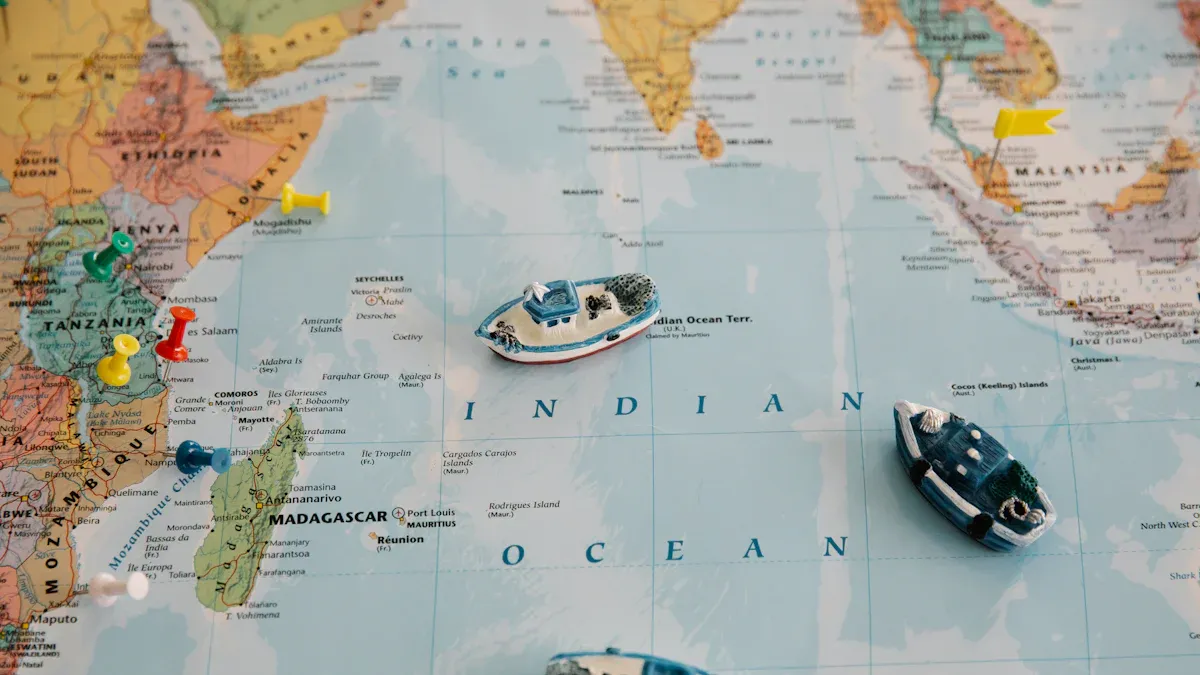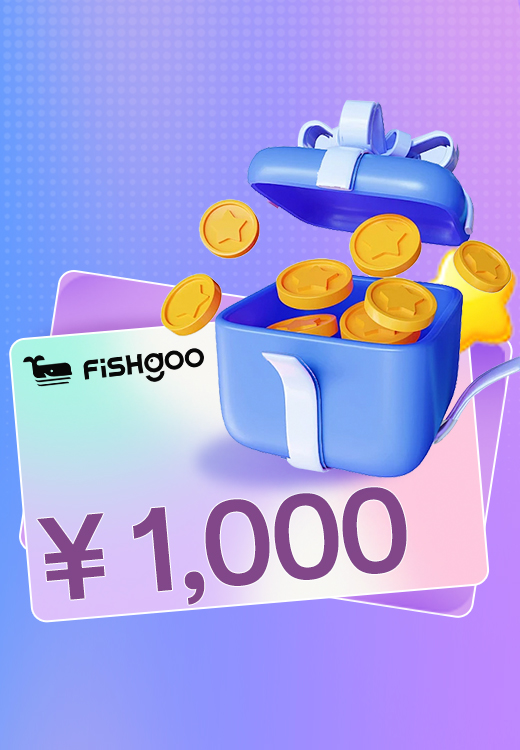Global logistics network and its cross-border routes

You live in a world where goods move between countries every day. A strong global logistics network helps products travel fast and safe. It connects buyers and sellers all over the world. Today, cross-border logistics helps e-commerce grow quickly. In 2024, the global cross-border e-commerce market was worth $1.98 trillion. Experts think it will be over $5 trillion by 2028. Platforms like Fishgoo let you shop from China easily. You can order, combine, and ship products without problems. Good logistics solutions help you find new products and markets.
Statistic Description | Value |
|---|---|
Global cross-border e-commerce market value (2024) | $1.98 trillion |
Projected global cross-border e-commerce value (2028) | Over $5 trillion |
Projected size of Global Cross-Border E-Commerce Logistics Market (2034) |
Key Takeaways
A strong global logistics network links buyers and sellers. This makes cross-border e-commerce easier and quicker. Using technology like real-time tracking helps you avoid delays. It also keeps your shipments safe. Customs rules can slow down shipping. Working with customs brokers helps you handle these problems. Package consolidation saves money and makes delivery faster. It does this by putting many orders into one shipment. Picking the right transport mode balances speed and cost. This helps you meet customer needs and care for the environment.
Global Logistics Network Overview
Key Components and Structure
When you buy something from another country, you use the global logistics network. This network has many important parts. Companies use hardware, software, and services to move goods. Software is the biggest part because it helps track packages and plan trips. Services are growing fast since more companies hire others to handle their shipping. There are different ways to move goods, like roadways, railways, airways, and waterways. Roadways are best for last-mile delivery because they are flexible and save money. Airways are growing fast because people want things delivered quickly.
Component/Mode | Description |
|---|---|
By Component | Hardware, software, and services make up the network. |
Software | Largest share, helps with tracking and optimization. |
Services | Growing fast, many companies outsource logistics. |
By Transportation | Roadways, railways, airways, and waterways move goods worldwide. |
Roadways | Best for last-mile delivery, flexible and cost-effective. |
Airways | Growing fast, needed for express shipments and global trade. |
Note: In the last ten years, companies started using big data, IoT, and cloud computing. These tools make logistics smarter and faster.
Major East-West Trade Routes
You may wonder which paths carry the most goods between continents. Some of the busiest trade routes link Asia, Europe, and the Middle East. These routes help move billions of tons of products every year.
Trade Route | Key Statistics |
|---|---|
English Channel | |
Malacca Strait | 25% of global goods, 96,000 vessels each year |
Strait of Hormuz | 20-30% of world’s oil, 21 million barrels daily |
Suez Canal | Over 20,000 vessels pass through each year |
These routes help keep the world’s supply chains working well.
Role of Leading Logistics Providers
You count on top logistics providers to deliver goods safely and on time. Companies like DHL, FedEx, and Maersk help move goods all over the world.
Provider | Role in Global Logistics Networks | Key Features |
|---|---|---|
DHL | Extensive global reach | 220+ countries, 260+ aircraft, thousands of warehouses |
FedEx | Time-definite air express | Global coverage, known for reliability |
Maersk | Ocean shipping leader | Full digital booking and tracking capabilities |
DHL works in more than 220 countries and territories.
FedEx is known for reliable air express services.
Maersk is a leader in ocean shipping with smart digital tools.
During the COVID-19 pandemic, DHL shipped millions of vaccine doses around the world. Their special cold-chain network and real-time tracking helped save lives.
Cross-Border Logistics Challenges

Customs and Regulatory Barriers
When you ship goods to other countries, you face many rules. Every country has its own import, safety, and labeling laws. If you do not follow these, your package can be delayed or stopped. Customs clearance takes longer if paperwork is missing or rules change. This makes delivery slower and costs more money.
Key Findings | Details |
|---|---|
$421 million | |
Product Categories Subject to Tariffs | 73% |
Complex Customs Categories | 42% of total shipment value |
High-Scrutiny Categories | Electronics, luxury goods, food products |
Customs rules are now a big problem for carriers. You need the right documents and help before shipping to avoid trouble. Many packages have electronics or luxury goods. These get extra checks from customs officers.
Tip: Customs brokers can help you ship faster. They know the rules and can guide you.
Fishgoo helps you with these problems. The platform lets you track your package at every step. You get alerts about your shipment. If you need to return something, Fishgoo’s return software makes it simple. You do not need to worry about customs forms or duty fees. Fishgoo works with partners to make returns easy and avoid extra costs.
Using more than one way to ship and free trade deals help too. Programs like C-TPAT and FAST make customs faster. Trade deals like USMCA make shipping easier between the U.S., Canada, and Mexico.
Payment and Currency Issues
You may have payment and currency problems when trading worldwide. Cross-border payments can take days to finish. Sometimes, you pay high and random fees. Exchange rates change fast and can change your final price. It is hard to track payments through many banks. Each country has its own payment rules.
Challenge | Description |
|---|---|
Complex and slow processing times | Cross-border payments can take two to five business days to settle, often due to multiple intermediaries involved, which can disrupt cash flow and complicate supply chain management, especially for SMEs. |
High and unpredictable fees | Costs associated with cross-border transactions can include hidden fees and currency conversion markups, averaging around 6.6% of the transaction value, which can hinder competition for SMEs and startups. |
Currency fluctuations | Exchange rates can change rapidly, impacting the final amount in a transaction, posing foreign exchange risk, particularly for smaller firms that may not have the means to hedge against these fluctuations. |
Lack of transparency | Tracking payments through multiple banks can be challenging, leading to difficulties in managing cash flow and keeping partners updated on payment statuses. |
Regulatory hurdles | Each country has its own regulations for AML, KYC, and other compliance measures, which can complicate the payment process and lead to legal penalties if not adhered to. |
Fishgoo makes paying easier for you. You can pay in your own money and see the rate before buying. The platform shows all fees, so you are not surprised. Fishgoo gives you many ways to pay. This saves time and helps you avoid mistakes.
Risk and Security Management
You must keep your shipments safe from risks and threats. Cyberattacks are a bigger problem now. For example, a ransomware attack in Japan stopped shipments for days. Cybersecurity problems in logistics have gone up by 48% in five years. The transport sector has 21% of all DDoS attacks in Europe.
Maritime ransomware attacks rose by 467% in one year.
State-sponsored attacks hit 64 cases in 2024.
A data breach in logistics costs $4.18 million on average.
Cargo theft is another big risk. You need strong security like GPS tracking and smart route planning. Fishgoo helps by working with trusted partners and giving real-time tracking. You can watch your shipment and feel safe.
Note: Using more than one way to ship and free trade deals can lower risks. Special lanes and faster customs checks mean fewer delays and less theft.
You face many problems in cross-border logistics. But with good partners and tools, you can solve them and keep your goods moving safely.
Solutions for Efficient Cross-Border Logistics
Technology and Real-Time Tracking
You can use new technology to make shipping smarter. Real-time tracking shows where your package is at all times. This helps you stop delays and keeps your goods safe. Today, tracking systems give live updates and send alerts if there is a problem. You can use these alerts to fix issues fast and plan better.
Real-time tracking helps you pick the best routes. This saves fuel and helps the planet.
You can check carbon emissions and see your impact on the environment.
Automated data sharing makes customs paperwork quick and easy.
AI analytics can guess delays and suggest new routes, so your packages arrive on time.
Tracking systems warn you if your cargo goes off its path, which helps stop theft.
Integrated platforms collect data from many carriers, so managing shipments is easier.
Automated messages keep everyone updated, so you always know what is happening.
When you use these tools, you talk better with your partners. You also make your shipping faster and more reliable.
Warehousing and Package Consolidation
Warehousing and package consolidation help you save money and get packages delivered faster. When you put many packages together, you only go through customs once. This stops delays that could add up to 10 days. You also pay less for shipping because you send fewer packages.
Combined shipments move through customs faster and avoid slowdowns.
Smarter freight flows, like less-than-truckload models, make your supply chain quicker and easier to grow.
Making your warehouse smaller means you keep less stock and deliver faster.
Package consolidation cuts shipping costs and makes logistics simpler.
Fishgoo’s one-stop service is a good example. You order, and Fishgoo does everything from buying to storing, checking, and shipping. The platform gives you 30 days of free storage and can save you up to 80% on shipping. You also get a 37% cut in shipment time and a 71% drop in LTL handling. This makes cross-border shipping much easier and cheaper.
Metric | Result |
|---|---|
Reduction in Shipment Time | 37% |
Reduction in LTL Handling | 71% |
Shipping Cost Savings | Up to 80% |
Free Storage | 30 days |
Multimodal Transport Optimization
You can move goods faster and cheaper by using more than one type of transport. This is called multimodal transport. It uses trucks, ships, trains, and planes to get your products where they need to go. Planning ahead and staying flexible helps you avoid problems and keep your shipments on track.
Measurable Benefits | |
|---|---|
Planning Ahead | Makes things work better and avoids problems. |
Flexibility | Helps you make quick choices when things change. |
Leverage Technology | Gives real-time updates and makes work easier. |
Build Strong Relationships | Makes switching between transport types smooth. |
Understand Regulations | Stops rule problems and keeps things moving. |
Reducing Traffic Congestion | Saves time, speeds up delivery, and makes shipping better. |
Environmental Benefits | Uses less energy and lowers carbon emissions. |
You can use technology to get live updates and change your route if there is traffic or bad weather. Building good relationships with carriers helps you switch between trucks, ships, or planes easily. Knowing the rules in each country keeps your shipments moving without stops.
Flexible payment options and global shipping lines help too. Paying in different ways stops delays and keeps your supply chain working. Paying on time helps you manage money and avoid problems. Using global shipping lines gives you more choices and better prices, so you spend less.
Tip: Work with cross-border logistics experts who know the rules and paperwork. This lowers your risk of fines and keeps your shipments moving.
By using these solutions, you make your logistics network stronger and faster. You deliver products quickly, save money, and keep your customers happy.
Optimizing Global Logistics Network
Route Planning and Cost Efficiency
You can make your global logistics network better by planning routes carefully. Good planning helps you skip traffic jams and avoid delays. This means your deliveries are faster and you use less fuel. Using smart tools lets you check traffic and weather before shipping. This helps you choose the best way for your packages.
Benefit | Description |
|---|---|
Optimized routes lead to lower fuel consumption during transport. | |
Reduced vehicle maintenance costs | Less wear and tear on vehicles results in lower upkeep expenses. |
Lower carbon emissions | Efficient routing can decrease emissions, potentially reducing tax liabilities. |
Try to stay away from busy roads and plan early. This keeps your shipments on time and saves you money.
Sustainability and Speed Trade-Offs
You sometimes have to pick between fast shipping and helping the planet. Air freight is quick but costs more and uses more energy. Sea freight is slower but cheaper and better for the earth. Land freight and intermodal choices give you a mix of speed and price.
Transportation Mode | Speed | Cost | Use Case |
|---|---|---|---|
Air Freight | Fast | High | High-value, urgent shipments |
Sea Freight | Slow | Low | Bulk commodities, large goods |
Land Freight | Varies | Medium | Domestic shipments, intermodal transport |
Intermodal | Moderate | Moderate | Blended approach for cost and speed |
Many big stores now want to be carbon neutral. You can do the same by picking greener ways to ship. Think about what your buyers want. Some want fast delivery, but others care about the environment.
Data-Driven Decision Making
You can use data to make your logistics smarter. Real-time tracking shows where your packages are and how they move. This helps you keep the right amount of stock and spend less money. Predictive analytics warn you about problems and help you stop delays.
Benefit | Description |
|---|---|
Optimized routing and pre-clearance programs lead to faster cross-border delivery. | |
Better Inventory Management | Real-time tracking aligns stock levels with transit data, reducing overstocking and understocking risks. |
Cost Control | Multimodal transportation and shipment consolidation minimize freight costs. |
Risk Mitigation | Predictive analytics help reduce shipment holds and penalties, ensuring smooth supply chain flow. |
To get better at logistics, you can use IoT devices for tracking and special management systems. Companies like SAP and IBM use these tools to keep things running well. You should work closely with your partners and change your plans when the market changes.
Tip: Check your suppliers, try new technology, and always follow trade rules. These steps help keep your global logistics network strong for the future.
You get lots of good things from a strong global logistics network.
You can find new buyers and sell in more places.
You spend less money by planning routes and using smart tools.
You work faster with better tracking and management systems.
You can team up with experts like Fishgoo to make shipping and paying simple.
To do better, plan your routes, track your shipments, and use smart warehouses. New trade deals and technology will help cross-border logistics become quicker and safer soon.
FAQ
How do I track my international shipment?
You use a tracking number from your logistics provider. Most websites show real-time updates. You can see every step, from the warehouse to your door. This helps you know where your package is and when it will arrive.
What is package consolidation, and why should I use it?
Package consolidation means putting many orders into one shipment. You pay less for shipping fees. You also get through customs faster. This is good for people who buy a lot and want to save money and time.
How does Fishgoo simplify cross-border shopping?
Fishgoo lets you buy from Chinese stores without a local phone or payment account. You copy the product link, pay in your own money, and Fishgoo does the rest. They buy, store, check, and ship your items. You get a simple and easy shopping experience.
Why is supply chain planning important in cross-border logistics?
Supply chain planning helps you stop delays and extra costs. You pick the best routes and ways to ship. You also keep track of your inventory better. Good planning keeps your business working well and your customers happy.
See Also
Maximizing Your Global E-Commerce Logistics for Success
Key Shipping Services for Newcomers in 2025
FISHGOO Freight Discounts: Save 5% and Get 10% Coupons
Understanding International Freight Forwarding and Its Importance


